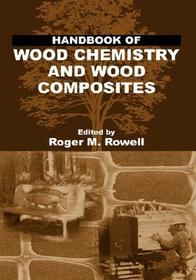
Handbook of Wood Chemistry and Wood Composites
- Publisher's listprice GBP 156.00
-
74 529 Ft (70 980 Ft + 5% VAT)
The price is estimated because at the time of ordering we do not know what conversion rates will apply to HUF / product currency when the book arrives. In case HUF is weaker, the price increases slightly, in case HUF is stronger, the price goes lower slightly.
- Discount 10% (cc. 7 453 Ft off)
- Discounted price 67 076 Ft (63 882 Ft + 5% VAT)
Subcribe now and take benefit of a favourable price.
Subscribe
74 529 Ft

Availability
Out of print
Why don't you give exact delivery time?
Delivery time is estimated on our previous experiences. We give estimations only, because we order from outside Hungary, and the delivery time mainly depends on how quickly the publisher supplies the book. Faster or slower deliveries both happen, but we do our best to supply as quickly as possible.
Product details:
- Edition number 1
- Publisher CRC Press
- Date of Publication 18 February 2005
- ISBN 9780849315886
- Binding Hardback
- No. of pages487 pages
- Size 254x177 mm
- Weight 1112 g
- Language English
- Illustrations 242 Illustrations, black & white; 112 Tables, black & white; 101 Halftones, black & white 0
Categories
Short description:
The Handbook of Wood Chemistry and Wood Composites analyzes the chemical composition, physical properties, and natural degradation processes. Contributors discuss the types of chemical modifications, their chemical mechanisms of reaction, and resulting changes in performance properties, including increased strength, water repellency, dimensional stability, fire retardancy, and resistance to biological organisms. Incorporating over 30 years of teaching experience, the editor of this handbook is well-attuned to educational demands as well as industry standards and research trends, providing an excellent guide to the latest applications, concepts, and technologies in wood chemistry and bio-based composites.
MoreLong description:
The degradable nature of high-performance, wood-based materials is an attractive advantage when considering environmental factors such as sustainability, recycling, and energy/resource conservation. The Handbook of Wood Chemistry and Wood Composites provides an excellent guide to the latest concepts and technologies in wood chemistry and bio-based composites.
The book analyzes the chemical composition and physical properties of wood cellulose and its response to natural processes of degradation. It describes safe and effective chemical modifications to strengthen wood against biological, chemical, and mechanical degradation without using toxic, leachable, or corrosive chemicals. Expert researchers provide insightful analyses of the types of chemical modifications applied to polymer cell walls in wood, emphasizing the mechanisms of reaction involved and resulting changes in performance properties. These include modifications that increase water repellency, fire retardancy, and resistance to ultraviolet light, heat, moisture, mold, and other biological organisms. The text also explores modifications that increase mechanical strength, such as lumen fill, monomer polymer penetration, and plasticization.
The Handbook of Wood Chemistry and Wood Composites concludes with the latest applications, such as adhesives, geotextiles, and sorbents, and future trends in the use of wood-based composites in terms of sustainable agriculture, biodegradability and recycling, and economics. Incorporating over 30 years of teaching experience, the esteemed editor of this handbook is well-attuned to educational demands as well as industry standards and research trends.
The degradable nature of high-performance, wood-based materials is an attractive advantage when considering environmental factors such as sustainability, recycling, and energy/resource conservation. The Handbook of Wood Chemistry and Wood Composites provides an excellent guide to the latest concepts and technologies in wood chemistry and bio-based composites.
The book analyzes the chemical composition and physical properties of wood cellulose and its response to natural processes of degradation. It describes safe and effective chemical modifications to strengthen wood against biological, chemical, and mechanical degradation without using toxic, leachable, or corrosive chemicals. Expert researchers provide insightful analyses of the types of chemical modifications applied to polymer cell walls in wood, emphasizing the mechanisms of reaction involved and resulting changes in performance properties. These include modifications that increase water repellency, fire retardancy, and resistance to ultraviolet light, heat, moisture, mold, and other biological organisms. The text also explores modifications that increase mechanical strength, such as lumen fill, monomer polymer penetration, and plasticization.
The Handbook of Wood Chemistry and Wood Composites concludes with the latest applications, such as adhesives, geotextiles, and sorbents, and future trends in the use of wood-based composites in terms of sustainable agriculture, biodegradability and recycling, and economics. Incorporating over 30 years of teaching experience, the esteemed editor of this handbook is well-attuned to educational demands as well as industry standards and research trends.
Table of Contents:
Preface
Wood and Society, Christopher D. Risbrudt
STRUCTURE AND CHEMISTRY
Structure and Function of Wood, Alex C. Wiedenhoeft and Regis B. Miller
Cell Wall Chemistry, Roger M. Rowell, Roger Pettersen, James S. Han, Jeffrey S. Rowell, and Mandla A. Tshabalala
PROPERTIES
Moisture Properties, Roger M. Rowell
Biological Properties, Rebecca E. Ibach
Thermal Properties, Roger M. Rowell and Susan L. LeVan-Green
Weathering of Wood, R. Sam Williams
Surface Characterization, Mandla A. Tshabalala
WOOD COMPOSITES
Wood Adhesion and Adhesives, Charles R. Frihart
Wood Composites, Lars Bergland and Roger M. Rowell
Chemistry of Wood Strength, Jerrold E. Winandy and Roger M. Rowell
Fiber Webs, Roger M. Rowell, James S. Han and Von Y. Byrd
Wood Thermoplastic Composites, Daniel F. Caulfield, Craig Clemons, Rodney E. Jacobson, and Roger M. Rowell
PROPERTY IMPROVEMENTS
Chemical Modification of Wood, Roger M. Rowell
Lumen Modifications, Rebecca E. Ibach and W. Dale Ellis
Plasma Treatment of Wood, Ferencz S. Denes, L. Emilio Cruz-Barba, and Sorin Manolache




